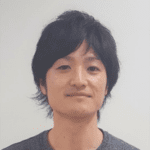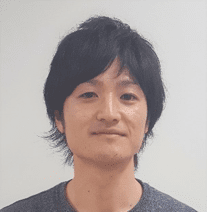Working hypothesis about phantom limb pain and movement representation
Patients with phantom limb pain (PLP) may report altered movement representations of their phantom limb, for example, ‘my phantom limb is frozen in one or more peculiar positions’. Dr. Sumitani previously reported that visual feedback using a mirror restored the voluntary movement representation of such a ‘paralysed’ phantom limb and simultaneously improved PLP. This observation generated a working hypothesis ‘distorted movement representation of a phantom limb induces pathological pain as the alarm sign of the limb abnormality’ (Sumitani M et al. Rheumatology 2008).
How did we reveal the working hypothesis in behavioral analysis?
First, we aimed to verify the working hypothesis by using the bimanual circle-line coordination task. In this task, participants repeatedly drew vertical lines using the intact hand while simultaneously intending to draw circles using the phantom limb. A previous case study reported that the vertical line movements with the intact hand were distorted when amputees draw the circles with a phantom limb (Franz EA and Ramachandran. Nature Neuro Sci 1998). We quantitatively evaluated the movement representation in nine patients with PLP using this ‘bimanual circle-line coordination task (BCT)’ and revealed that there was a linear relationship between the degree of oval-shaped transfiguration of the vertical lines and PLP intensity (Osumi and Sumitani et al.Neurosci Lett 2015). Therefore, we considered the BCT to be an appropriate assessment tool for quantifying movement representations of a phantom limb and supported our working hypothesis.
Restoring movement representation of phantom limb alleviates phantom limb pain
Movement representations are systemically structured through the integration of movement intention and sensory feedback (Wolpert et al Science 1995). In the case of amputee patients, patients cannot perceive somatosensory feedback of the amputated limb associated with its motor intention, and it is thought that loss of somatosensory feedback is associated with the gradual decay of movement representations and the emergence of PLP. There I ssome evidence that precise visual feedback of phantom limb movements may be a substitute for somatosensory feedback. We conducted neuro-rehabilitation using a virtual reality (VR) system for eight patients with PLP (Osumi and Sumitani et al. Eur J Pain 2017). Our VR system created a moving mirror image of the intact upper limb using motion capture technology, and projected the virtual-image of a phantom limb onto a head-mounted display in real time. The head-mounted display allowed participants the virtual illusory experience of moving their phantom limb at their own discretion. PLP was alleviated immediately after the virtual illusion in seven participants. Further, the degree to which PLP was alleviated was significantly correlated with restoring movement representations as quantitatively measured by the bimanual circle-line coordination task. We reasoned that repeated experiences of congruency between motor intention and sensory feedback of a phantom limb restored movement representation in these participants. That is, precise movement representation of a phantom limb was thought to be re-constructed by reference to visuo-somatosensory feedback from the intact hand through symmetric bimanual movements.
We supported the working hypothesis ‘distorted movement representation of a phantom limb induces pathological pain as the alarm sign of limb abnormality’. Further investigations that probe the long-term effect of the neuro-rehabilitation using VR for patients with phantom limb pain are needed.
Acknowledgments
Professor Yasuo Kuniyoshi, Dr. Yuko Sano and Mr. Akimichi Ichinose, Intelligent Systems and Informatics Laboratory, Department of Mechano-Informatics, Graduate School of Information Science and Technology, the University of Tokyo; Associate Professor Shin-ichiro Kumagaya, Research Center for Advanced Science and Technology, the University of Tokyo; Professor Shu Morioka, Neurorehabilitation center, Kio University contributed to this research.
About the authors
 Michihiro Osumi is a Japanese physiotherapist and works as an Assistant Professor in Kio University. He completed his Ph.D. in 2015 at Kio University. He is interested in movement disorder and physical therapy for chronic pain.
Michihiro Osumi is a Japanese physiotherapist and works as an Assistant Professor in Kio University. He completed his Ph.D. in 2015 at Kio University. He is interested in movement disorder and physical therapy for chronic pain.
 Masahiko Sumitani works as the department director of Department of Pain and Palliative Medicine, The University of Tokyo Hospital in Japan. He has investigated an intimate relationship between sensorimotor integration and pathological pain.
Masahiko Sumitani works as the department director of Department of Pain and Palliative Medicine, The University of Tokyo Hospital in Japan. He has investigated an intimate relationship between sensorimotor integration and pathological pain.
References
Sumitani M, Miyauchi S, McCabe CS, Shibata M, Maeda L, Saitoh Y, Tashiro T, Mashimo T. Mirror visual feedback alleviates deafferentation pain, depending on qualitative aspects of the pain: a preliminary report. Rheumatology (Oxford). 2008 Jul;47(7):1038-43.
Franz EA, Ramachandran VS. Bimanual coupling in amputees with phantom limbs. Nat Neurosci. 1998 Oct;1(6):443-4.
Osumi M, Sumitani M, Wake N, Sano Y, Ichinose A, Kumagaya S, Kuniyoshi Y, Morioka S. Structured movement representations of a phantom limb associated with phantom limb pain. Neurosci Lett. 2015 Sep 25;605:7-11.
Wolpert DM, Ghahramani Z, Jordan MI. An internal model for sensorimotor integration. Science. 1995 Sep 29;269(5232):1880-2.
Osumi M, Ichinose A, Sumitani M, Wake N, Sano Y, Yozu A, Kumagaya S, Kuniyoshi Y, Morioka S. Restoring movement representation and alleviating phantom limb pain through short-term neurorehabilitation with a virtual reality system. Eur J Pain. 2017 Jan;21(1):140-147.



